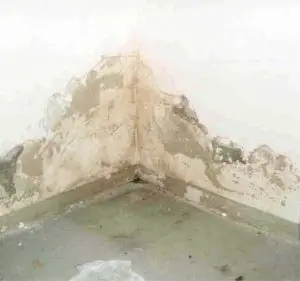First winter without insulation – moisture issues in new builds
The main cause is the combination of low outdoor temperatures and indoor heating, which leads to condensation—especially on the concrete elements of the structure. Concrete absorbs more moisture than brick walls, making the joints between concrete slabs and walls the first visible indicators of this issue...
Case study: from Pesnica, Slovenia: Moisture after ventilation shutdown
In the new home of our customer from Pesnica near Maribor, where we installed a central ventilation system with heat recovery in 2024, the system was temporarily shut down during interior finishing works (ceiling and wall sanding) to prevent dust from entering the ventilation system.
Within just three days of turning the system off, wet spots appeared on the walls -clearly showing how quickly moisture accumulates without continuous ventilation.
After the ventilation system was turned back on, the walls dried out completely within two days. This case confirms that effective ventilation is the only reliable way to eliminate excess moisture from a building

How to manage moisture in new homes during floor and wall drying?
During the construction phase—especially while drying screeds and plasters—moisture levels in the air rise significantly. Today, underfloor heating with a heat pump is commonly used to dry screeds. During this time, relative humidity can reach up to 100%. If this moisture isn't ventilated out, it absorbs into the walls and floors, significantly extending drying times and potentially causing permanent moisture problems.
Ventilation Is crucial even during construction
For effective drying of a new build, the following is essential:
✅ Continuous ventilation – Mechanical ventilation with heat recovery ensures constant air exchange without heat loss.
✅ Moisture removal from the building – Without ventilation, moisture is absorbed into floors and walls, delaying drying .
✅ Mold prevention – High humidity combined with warmth creates ideal conditions for mold growth
✅ Faster façade preparation – A dry structure allows for quicker progress with façade installation and other works.
Our customer’s experience clearly demonstrates that controlled ventilation is vital in new builds to prevent moisture-related problems. If ventilation is not properly provided, moisture accumulates within the structure, potentially causing long-term damage to walls and façades. It is also important to note that during dusty construction phases, the ventilation system should be turned off to prevent dust from entering the ducts.
🔗 Learn more about ventilation in new builds and how ventilation systems help:
- How does heat recovery ventilation work and why do you need it?
- Moisture and mold: How to prevent it effectively?
Need help choosing the right ventilation system for your new build? Contact us – we will be happy to help!
